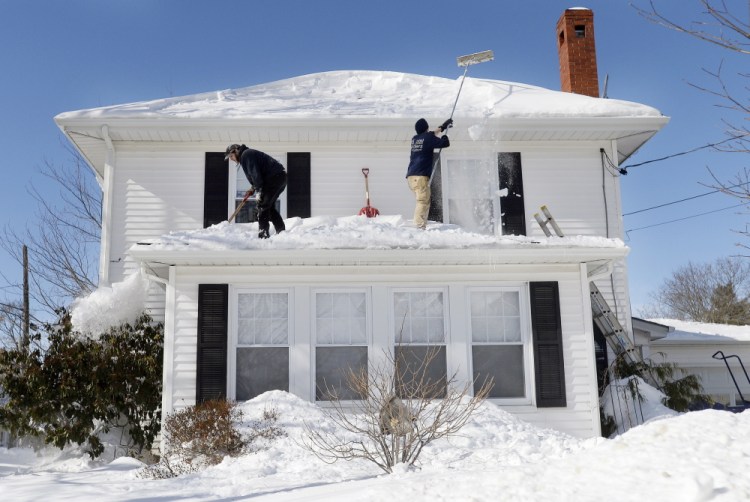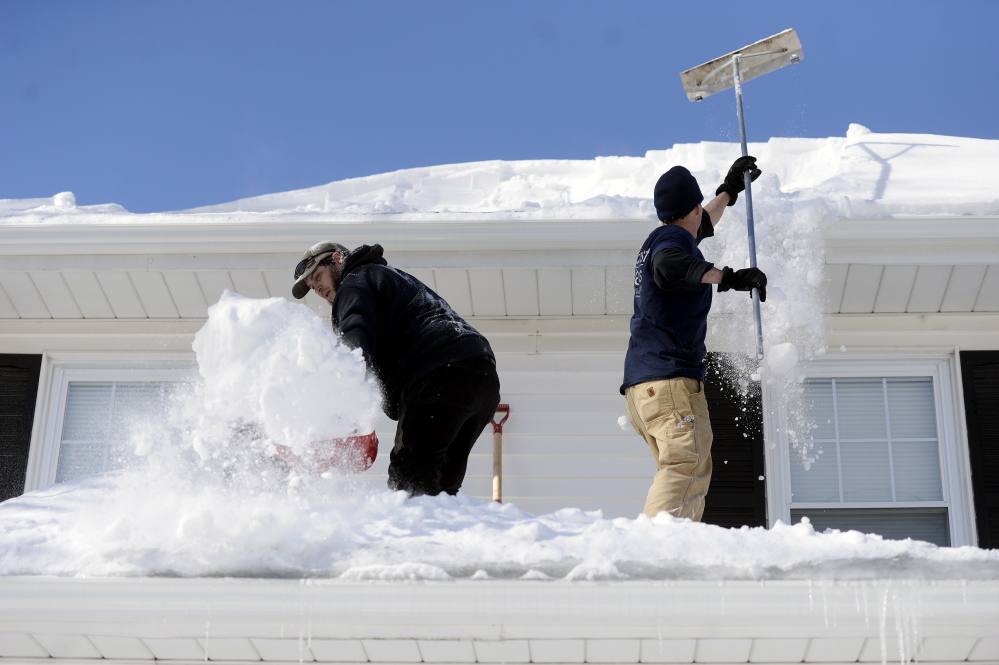Homeowners in Maine have probably asked themselves the same question in the past couple of weeks.
Should I call someone to clear all that snow off my roof? Or should I (gulp) try to do it myself?
There’s no clear answer, and opinions conflict on how necessary it actually is.
Advertisements for roof snow removal abound, with some even foretelling catastrophes if homeowners don’t act soon. Forecasts calling for even more snowfall can add to the sense of panic.
Even public officials have sounded alarms, warning residents to clear the rising inches of snow.
Steven Boucouvalas, emergency management director for the city of Saco, issued a media release Tuesday advising people that removing snow and ice buildup from roofs “is extremely critical and can’t be over-emphasized.”
But others say Maine roofs are built to withstand a certain amount of weight and are pitched to ensure that the full weight of the snow doesn’t directly push down on the roof.
As Mainers continue to shovel out from record levels of snow in the past couple of weeks and look ahead to another potentially significant snowstorm this weekend, many are still nervous about whether to leave the piles alone.
“I normally don’t worry about it, but there are some drifts on my roof that concerned me,” said Robert MacArthur of South Portland, who was shopping for a roof rake Wednesday afternoon at Home Depot.
A store employee informed MacArthur that the store – and nearly every other Home Depot in Maine – had been cleaned out of roof rakes.
“I guess I’ll look somewhere else,” he said. “I don’t really want to pay someone to go up there.”
HOW MUCH SNOW ON ROOF IS TOO MUCH?
There are no hard and fast rules for clearing snow off roofs, in part because there are so many variables in home construction, how much insulation a home has, and how steep a roof is.
In general, though, engineers say most homes can handle even the record snowfall that Maine has seen so far this year.
Bruce MacLeod, a structural engineer based in Gorham, said most roofs in Maine are built to withstand 40 pounds per square foot, sometimes more.
The Insurance Institute for Business and Home Safety estimates that 1 foot of fresh, average snow is equal to about 1 inch of water, which is the equivalent of about 5 pounds per square foot.
The institute uses 20 pounds per square foot as a safe standard, which means you could theoretically leave 4 feet of snow on your roof without any problems.
However, snow gets heavier as it packs down over time. The Insurance Institute says 6 inches of packed snow is also equivalent to 5 pounds per square foot, meaning the snow on a roof shouldn’t exceed 2 feet.
MacLeod said that in his experience, most Maine homes can handle about 3 feet of average snow before a roof’s integrity might be compromised.
Helen Watts, an engineer from Bowdoin, agreed.
“If a home is built to code, it should be fine,” she said.
FLAT ROOFS ALLOW THE MOST BUILDUP
Most houses in Maine, whether they are one-story ranches or two-story capes and colonials, have pitched roofs that help keep snow from piling up.
Fortunately, the recent heavy snow has mainly been the fluffy variety. And temperatures have remained cold, so there has been no rain that would saturate and weigh down the snow.
Flat roofs, however, are more problematic because the snow can’t slide off.
Many businesses in Maine have flat roofs. Mike Davis, vice president of Industrial Roofing Companies, based in Lewiston, said his crews have been busy assisting many such firms in the past two weeks.
Davis said that although his company makes money clearing roofs, that doesn’t mean clearing is always the best route.
“We don’t want to go up there unless we have to,” he said.
BE ALERT FOR ICE DAMS, RAINY WEATHER
One sign that a roof might be in trouble is when interior doors begin to stick, a possible signal that the frame has been distorted. Similarly, cracks in the plaster or drywall around doors could be a sign.
But Jim Thibodeau, an engineer from Falmouth, said most wood-frame structures are “extremely resilient.”
“Most can handle even substantial snow loads,” he said. “But if you have buildings that are older or have had problems before, then you want to be a little more careful.”
The more significant danger, engineers say, are ice dams that form on roofs when the snow melts, runs down the roof, refreezes and clogs gutters. As more snow continues to melt and block the gutters, water can seep under the shingles and leak inside a house.
One sign of potential ice dams is an excessive number of icicles. A home with a well-insulated and well-ventilated attic is less likely to produce icicles and less likely to be subject to ice dams.
Portland-based Clark Insurance is warning customers to keep an eye on their roofs, even if they look fine.
“Though the 10-day forecast in the region calls for temperatures in the teens and twenties, a major thaw or an unexpected rainstorm could sweep into New England and produce disastrous results, from collapsing roofs and decks to basement flooding,” said President Ken Ross. “We are only 39 days away from spring, which is a reminder that temperatures and weather conditions can change dramatically in a matter of days.”
HESITANT TO CLIMB, OR PAY OTHERS TO DO IT
Homeowners can buy length-adjustable roof rakes, which start at about $40, to clear snow themselves. The cost to have a roof professionally cleared is likely to be $200 or more.
But even clearing a couple of feet of snow from the edge of the roof can make a difference.
Nate Hull, who owns a three-story apartment building in Portland’s West End, said he’s never considered having his roof cleared before, but found himself outside last weekend clearing a stubborn drift.
“I think there is a struggle for many owners, particularly here because the buildings are vertical,” he said. “You don’t want to go up there yourself, but it can be costly to hire someone.”
Send questions/comments to the editors.





Success. Please wait for the page to reload. If the page does not reload within 5 seconds, please refresh the page.
Enter your email and password to access comments.
Hi, to comment on stories you must . This profile is in addition to your subscription and website login.
Already have a commenting profile? .
Invalid username/password.
Please check your email to confirm and complete your registration.
Only subscribers are eligible to post comments. Please subscribe or login first for digital access. Here’s why.
Use the form below to reset your password. When you've submitted your account email, we will send an email with a reset code.